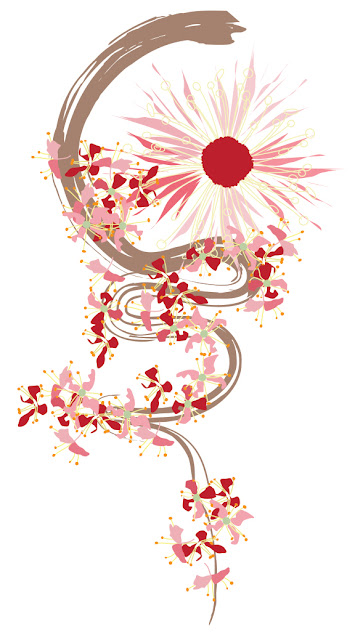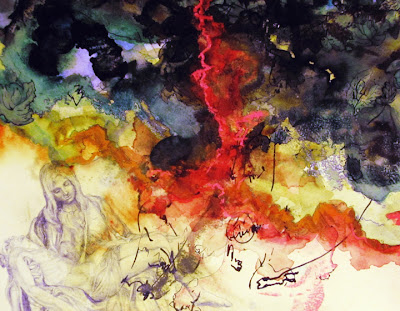One digital painting on which I am currently working, is a compelling project in itself, involving blending a gorgeous mountain waterfall cascade with a pair of intertwined lovers. This is one unfinished part of a larger work in progress.
It's actually quite a lot of busy work, using the Mixer Brush to create a "painted" digital image from several photograph pieces, and then knit them together and sink one into the other with the Photoshop painting tools. Zooming in close will give you and idea of the amount of work, just in the Mixer Brush phase.
Yet, once you get the hang of it and set your options the way that feels most like paint (in my case, going for an oil paint on canvas feel), using the Mixer Brush can be quite meditative and relaxing. You can really get into that flow of mixing and pushing paint around, which is so famously therapeutic in painting with real paint. Close-up, the photographic forms melt away and you begin to see only colors and basic shapes.
Photoshop has an interesting way of inventing strange color spots, called artifacts, when you add resolution and use certain color adjustments. That would normally be annoying and corrosive to the image, but when painting like this, you can use that to your advantage, pushing and enhancing those spots of colors for beautiful effects.
Add to that the ability to plug into millions of free music channels on iTunes, and Photoshop painting can turn into downright bliss. On an iTunes radio station, I found "Calm Radio" and I was so impressed with their mixer app that I signed up for a membership:
https://www.calmradio.com/index.php
So now, while I paint waterfalls, I can listen to Gregorian chanting monks, mixed with a waterfall background. I throw in wind chimes and a roiling thunderstorm (they let you mix 4 channels) for good measure, and I paint in a sort of calm pleasure coma for hours.
I think it may be affecting my work. Just gotta make sure to choose the right channels...
Another piece that I first started noticing the flow while working, I found myself thinking of as "making love to" when I would get to work on it. In this case, it was fig leaves--I know, sort of a weird way to think about fig leaves, but take a look!
How else do you make love to a painting of fig leaves than this? (Yes, fig leaves are what is usually depicted covering private parts in classical paintings, that's not what I had in mind, but that imagery actually works for the final product...)
Again, it comes down to colors and shapes, when zoomed in so close. And since you don't need to bother with the mess of mixing those colors in the physical world, it's even more relaxing.
I hadn't found Calm Radio by the time I finished the fig leaves, and I wonder how that might have affected them. That's worth keeping track of...




























